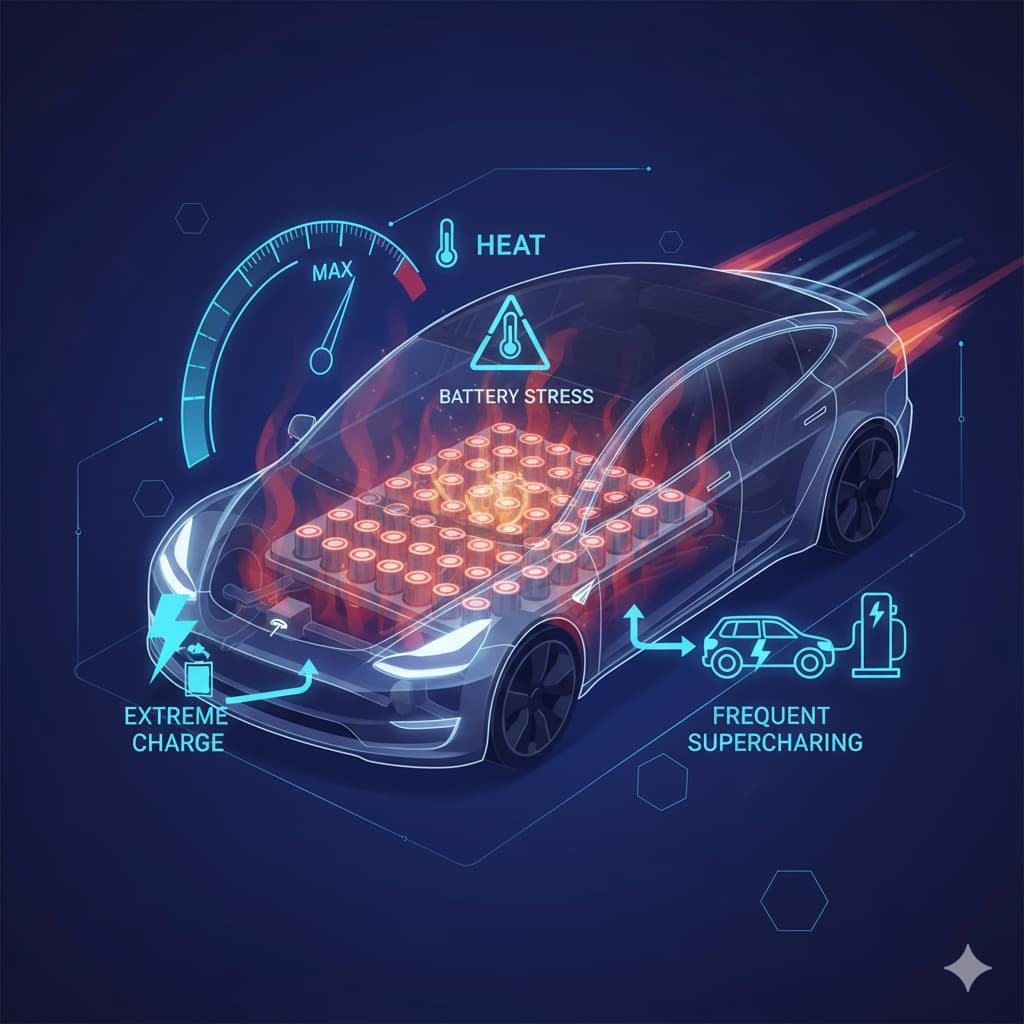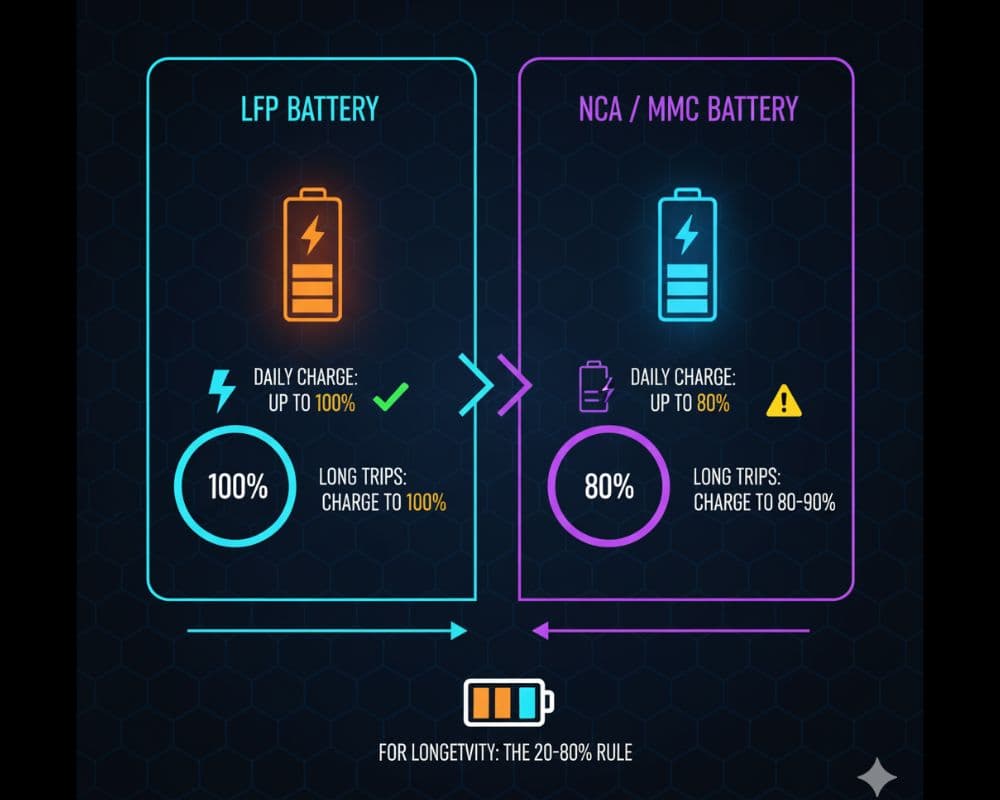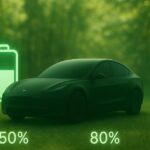Your Tesla’s battery will lose some of its power over time. This is normal for an electric car. We call this loss “Tesla battery degradation.” It means your car drives a shorter distance on a full charge. The good news is the loss is usually slow. You control how fast it happens.
Most Tesla batteries lose about 5% of their power in the first year. Then the speed of this power loss slows down a lot. Tesla’s own information shows batteries lose only about 12% of power after 200,000 miles of driving.
The guide explains why battery degradation happens. More importantly, it gives you simple steps to stop it. You can keep your Tesla’s battery healthy and make it last longer. Just make small changes to how you charge and drive the car.
What is Tesla Battery Degradation?
Battery degradation is when a lithium-ion battery slowly loses its power to hold energy. You can think of it like a gas tank that gets smaller over the years. When the battery in your electric car (like a Tesla) degrades, its total capacity gets smaller. This directly cuts down the farthest you can drive on a full charge.
Two main things cause this to happen: calendar aging (time passing) and cycle aging (how you use the car). You cannot stop time from moving forward. However, you can control how you use your car to make the degradation process slower.
Main Causes of Tesla Battery Degradation
To stop your battery from getting worse, first understand what causes it. Three main things hurt your battery: heat, keeping it too full or too empty, and charging it too fast.

1. High Temperatures and Heat
Heat is the biggest problem for any lithium-ion battery, like the one in your electric car.
Here are the top three ways heat harms your battery:
a. Hot Weather: Parking your car in direct, hot sunlight makes the battery hotter. This extra heat speeds up the chemical reactions inside. These fast reactions cause damage (called degradation) to the battery much faster.
b. Aggressive Driving: When you drive hard—like speeding up and slowing down quickly (rapid acceleration and deceleration)—you create heat inside the battery pack.
c. Frequent Supercharging: Supercharging is a quick way to charge (it’s also called DC fast charging). However, it makes more heat than using a slow charger at home (Level 2). Doing this fast charge too often stresses and harms the battery.
2. Extreme States of Charge (SOC)
Keeping your battery almost full or almost empty is hard on its parts, called cells.
a. Charging to 100%: When you leave your battery at a full 100% charge for a long time, it causes the cells a lot of stress. This is especially true for batteries that are not LFP (Lithium Iron Phosphate) types.
b. Draining to 0%: Running your battery until it is almost at zero (below 10 to 20%) also stresses the cells. You should avoid doing this.
3. High Mileage and Charge Cycles
Every time you fill up your battery and then use it up, it finishes one “cycle.” This cycle makes the battery wear out slowly, which is called Cycle Aging. The more you drive and the more often you charge, the more cycles the battery completes. This means the battery will slowly lose its power, or capacity. You often see the battery wear out fastest in the first 25,000 miles. After that, the rate of wear slows down.
4. Cold Weather (Temporary Range Loss)
Cold weather does not cause permanent damage. It significantly affects performance and range for a short time.
Reduced Efficiency Cold temperatures slow down the chemical reactions inside the battery. This makes the battery less efficient at giving power. It also reduces the available range until the battery warms up.
How to Maximize Your Tesla’s Battery Life

The best way to prevent rapid battery degradation is to manage your charging habits and minimize exposure to extreme conditions.
1. Optimize Your Daily Charging Limit
This is the single most important thing you can do for battery health.
| Battery Type | Daily Charging Recommendation | Long Trip Charging Recommendation |
|---|---|---|
| LFP (Standard Range) | Charge to 100% regularly (at least once a week) | Charge to 100% just before leaving |
| NCA/NMC (Long Range / Performance) | Charge to 80–90% for daily use | Charge to 100% only when needed for a long trip |
Actionable Tip: Actionable Advice: Set your charge limit in the Tesla app or car screen to the recommended level for your battery type. Only charge to 100% right before a long journey.
2. Minimize Supercharging
Superchargers work well for long drives, but they shouldn’t be your main way to charge.
Use home charging. Charge at home or at work as much as you can. Level 1 uses a regular plug. Level 2 uses a Wall Connector. Slower charging is cooler and kinder to the battery.
- When you Supercharge, use the car’s map to find the Supercharger.
- The car warms the battery to the best heat.
- Warming the battery makes charging faster and easier on the battery.
3. Manage Temperature Extremes
Keeping a Tesla away from too much heat and cold will help keep its battery strong. Avoid very hot weather. Park the car under a shady spot or inside a garage when summer is hot. If the car must sit outside, use the Cabin Overheat Protection setting. Know that the setting uses a little bit of the battery.
Pre-Conditioning in Cold: Before driving when the weather is cold, warm up the car’s inside and the battery. Do this while the car is still plugged in. Warming the battery this way uses power from the wall, not the car’s battery. This makes sure the car gets the best driving distance and works best right from the start.
4: Avoid Deep Discharges
Try to keep your battery above 20% charge whenever possible.
The 20-80 Rule: While 80-90% is the ideal top limit, the 20% bottom limit is just as important. Avoid letting the battery drop below this level for extended periods to reduce stress on the cells.
Case Study
A 2018 Model 3 Long Range car owner shared their experience. The owner’s car had a battery capacity of 310 miles. After the first year and about 20,000 miles, the capacity went down to about 295 miles. This was a 5% loss. The capacity dropped only 5 more miles over the next three years and another 60,000 miles. The first drop is the biggest one. After that, the drop becomes much smaller.
Large studies agree with this personal story. The way the battery loses capacity is not a straight line. The battery capacity drops fast at the beginning. Then, the speed of the loss slows down a lot.
| Mileage (Approx.) | Average Capacity Loss (Non-LFP) | Degradation Rate |
|---|---|---|
| 25,000 miles | 5% | Steepest |
| 50,000 miles | 7% | Slowing |
| 100,000 miles | 10% | Very Slow |
| 200,000 miles | 12% | Minimal |
Expert Insight: The initial drop is often due to the battery management system (BMS) calibrating and a small, unavoidable physical change in the cells. After this initial phase, the battery chemistry stabilizes, and the loss rate becomes much slower, provided you follow good charging practices.
Conclusion
Tesla battery degradation is an expected part of EV ownership, but it is not a cause for panic. The initial loss is the steepest, and the rate of degradation slows down significantly over time.
By adopting a few simple, smart habits—primarily setting your daily charge limit to 80-90% (or 100% for LFP) and minimizing Supercharging—you can effectively slow down the degradation process. Your Tesla is designed to last, and with a little care, you can ensure your battery remains healthy for hundreds of thousands of miles.
FAQs
Is 10% battery degradation after 3 years normal for a Tesla?
Yes, 10% degradation after 3 years is considered very normal for a Tesla. Many owners see about 5% loss in the first year, and then the rate of loss slows down dramatically. The battery management system often stabilizes after the initial period, leading to a much slower decline in capacity.
How can I check my Tesla’s battery health?
Tesla does not provide a simple “battery health percentage” number to the owner. The best way to estimate your battery health is to compare your current full charge range (the miles shown at 100% charge) to the original EPA-rated range for your specific model when it was new. You can also use third-party apps or services that read the car’s data, but these should be used with caution.
Does Supercharging permanently damage the battery?
No, Supercharging does not “damage” the battery, but frequent, exclusive use of DC fast charging can accelerate the rate of degradation compared to slower AC charging.
The heat generated during fast charging is the main factor. It is best to use Supercharging for long trips and rely on home or Level 2 charging for daily use.
Should I charge my LFP battery to 100% every day?
If your Tesla has the LFP (Lithium Iron Phosphate) battery, Tesla suggests charging it to 100% at least once a week.
The LFP battery chemistry experiences less stress at a high state of charge. The 100% charge helps the Battery Management System (BMS) accurately measure the estimated range.
What is the ideal charge level for a Tesla battery?
For daily driving, the ideal charge level for non-LFP batteries (Long Range/Performance) is between 50% and 90% 6.
For LFP batteries (Standard Range), the ideal daily charge is 100%. The key is to avoid keeping the battery at 100% or below 20% for long periods.







